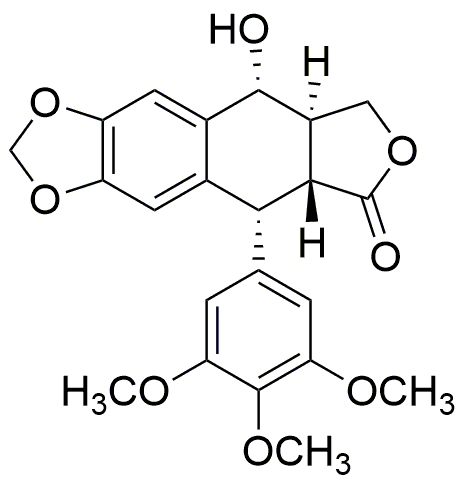Podophyllotoxin is widely utilized in research focused on:
- Anticancer Treatments: This compound is a key ingredient in the development of chemotherapeutic agents, particularly for treating testicular cancer and certain types of leukemia. Its ability to inhibit cell division makes it effective in targeting rapidly dividing cancer cells.
- Antiviral Applications: Podophyllotoxin has shown promise in treating viral infections, particularly human papillomavirus (HPV). It is used in topical treatments for warts caused by HPV, providing a non-invasive option for patients.
- Pharmaceutical Research: Researchers are exploring its potential as a lead compound for synthesizing new derivatives with enhanced efficacy and reduced toxicity. This opens doors for innovative drug development in oncology and virology.
- Natural Product Chemistry: As a naturally occurring compound, it serves as a model for studying plant-derived substances. This research can lead to the discovery of new therapeutic agents and contribute to the field of herbal medicine.
- Biochemical Studies: Podophyllotoxin is used in laboratory settings to study its mechanisms of action on cellular processes. Understanding these mechanisms can help in designing better-targeted therapies for various diseases.
General Information
Properties
Safety and Regulations
Applications
Podophyllotoxin is widely utilized in research focused on:
- Anticancer Treatments: This compound is a key ingredient in the development of chemotherapeutic agents, particularly for treating testicular cancer and certain types of leukemia. Its ability to inhibit cell division makes it effective in targeting rapidly dividing cancer cells.
- Antiviral Applications: Podophyllotoxin has shown promise in treating viral infections, particularly human papillomavirus (HPV). It is used in topical treatments for warts caused by HPV, providing a non-invasive option for patients.
- Pharmaceutical Research: Researchers are exploring its potential as a lead compound for synthesizing new derivatives with enhanced efficacy and reduced toxicity. This opens doors for innovative drug development in oncology and virology.
- Natural Product Chemistry: As a naturally occurring compound, it serves as a model for studying plant-derived substances. This research can lead to the discovery of new therapeutic agents and contribute to the field of herbal medicine.
- Biochemical Studies: Podophyllotoxin is used in laboratory settings to study its mechanisms of action on cellular processes. Understanding these mechanisms can help in designing better-targeted therapies for various diseases.
Documents
Safety Data Sheets (SDS)
The SDS provides comprehensive safety information on handling, storage, and disposal of the product.
Product Specification (PS)
The PS provides a comprehensive breakdown of the product’s properties, including chemical composition, physical state, purity, and storage requirements. It also details acceptable quality ranges and the product's intended applications.
Certificates of Analysis (COA)
Search for Certificates of Analysis (COA) by entering the products Lot Number. Lot and Batch Numbers can be found on a product’s label following the words ‘Lot’ or ‘Batch’.
*Catalog Number
*Lot Number
Certificates Of Origin (COO)
This COO confirms the country where the product was manufactured, and also details the materials and components used in it and whether it is derived from natural, synthetic, or other specific sources. This certificate may be required for customs, trade, and regulatory compliance.
*Catalog Number
*Lot Number
Safety Data Sheets (SDS)
The SDS provides comprehensive safety information on handling, storage, and disposal of the product.
DownloadProduct Specification (PS)
The PS provides a comprehensive breakdown of the product’s properties, including chemical composition, physical state, purity, and storage requirements. It also details acceptable quality ranges and the product's intended applications.
DownloadCertificates of Analysis (COA)
Search for Certificates of Analysis (COA) by entering the products Lot Number. Lot and Batch Numbers can be found on a product’s label following the words ‘Lot’ or ‘Batch’.
*Catalog Number
*Lot Number
Certificates Of Origin (COO)
This COO confirms the country where the product was manufactured, and also details the materials and components used in it and whether it is derived from natural, synthetic, or other specific sources. This certificate may be required for customs, trade, and regulatory compliance.


